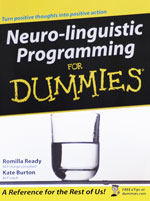NLP - What it is and what it can do for you
What is NLP?
Neuro-linguistic Programming (NLP) can be defined as the ‘structure of subjective experience’. This means that when you experience the same event as other people - perhaps you witness an accident or see the same film - each person interprets the same event in different ways.
This is due to the way you interpret and represent external events in your mind. It is influenced by filters that are very individual to you, having evolved as a result of your unique life experiences.
Neuro refers to your nervous system and how you think. After you gather and filter information about the world through your senses, you translate it into thoughts which affect your physiology, emotions and behaviour.
Linguistic refers to the way you use verbal and non-verbal language to communicate.
Programming refers to patterns of thought and behaviour that you have developed over your life and use almost without thinking and which are personal to you.
Bringing unconscious thinking and behaviour into your conscious awareness gives you the power of choice over your emotions and your actions
What NLP can do for you
The power of NLP lies in its ability to give you an awareness and understanding of how people think.
Even more powerful is that by understanding how you think and behave, you can choose to change your thinking and behaviour. You can do more of what works for you to create the results you want in your life and less of what gets in the way of your success.
Once you understand how someone else thinks, especially, what motivates them and triggers their emotional responses, you can adapt your language and behaviour to match that of the person (or people) with whom you're communicating, ensuring your message is heard and understood.
Understanding human thinking makes for powerful change management, whether in business or in your personal life. Selling ideas and products, too, becomes much easier; you can facilitate someone to buy instead of having to force them through a long drawn out sales process.
Try the following exercise:
- Think of someone you like
- Notice some of the qualities of the image in your mind's eye
N.B. Not everyone sees clear pictures in their mind. If you're one of these people, notice if you have an idea of what the person looks like, what you hear (it could be they have a particular way of saying something) or any feelings that come up for you.
Is the picture bright or dim, big or small, close or far? Where is it located? Use the arrangement of a clock face to notice whether the image is at 2 o’clock, 9 o’clock or some other number?
- Take a deep breath, look around you, perhaps move around (this is called 'breaking state' in NLP jargon)
- Now think of someone you don’t like
- Notice some of the qualities of this picture
Did you notice the differences in the way you saw the two people? There is no right or wrong answer. What is important is that you recognise that there are differences between what you saw (heard and felt).
Tip for dealing with people you find difficult:
Before you meet your ‘difficult person’, you may feel tense or find yourself having negative thoughts. These feelings and thoughts can have an adverse affect on you, on how you communicate with your difficult person and ultimately on the results you want to create. Instead, if you keep yourself positive and relaxed, you will stay more resilient and even surprise yourself with how well the meeting goes.
Discover more about learning practical uses of NLP by visiting 'Applied NLP for Profitable Business Results™' or contact Romilla.
